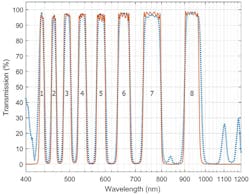Optical coatings, filters, and thin-film technologies maker Alluxa (Santa Rosa, CA) has developed 15-band optical filters for use in the Exoplanet Transmission Spectroscopy Imager (ETSI) instrument at Texas A&M University’s Mitchell Institute for Fundamental Physics and Astronomy, and Department of Physics & Astronomy (College Station, TX). The ETSI can examine hundreds of exoplanet transmission spectra from a ground-based observatory using small- to medium-class telescopes.
The ETSI makes use of a new characterization technique called common-path multiband imaging (CMI). The optical design of the instrument includes a prism and Alluxa’s multiband optical filters to simultaneously image 15 bandpasses on two detectors (from 430 to 975 nm) during exoplanet transits of a bright star. The design enables the ETSI to achieve unprecedented photometric precision during transit spectroscopy measurements.
Mike Scobey, a co-author of the paper and CEO at Alluxa, says that CMI should also scale into larger and more sensitive telescopes, with the potential to facilitate detection of the first habitable planets outside the solar system.
CMI could also offer a gateway for characterizing almost all transiting exoplanets and potential habitability from ground-based observatories, according to the collaborative white paper from Texas A&M University and Alluxa.
